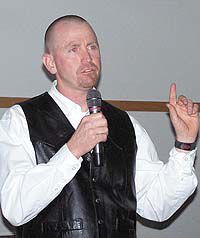| Wade Allinson tells the Emery County Historical Society of etchings he has found in the San Rafael done by early travelers in the area. |
The meeting was opened by Joyce Staley. The first order of business was to elect officers. Joyce Staley was elected president. Dottie Grimes vice chair, Evelyn Huntsman secretary, and Dixie Swasey treasurer,
First a report from Grimes of the Emery County Archives who gave a history of the Wilberg Resort that once was located North of Castle Dale. This resort was operated by the Wilberg family. It was started before the 1929 Depression and continued into the 30s during the depression and drought.
The Wilberg Resort gave the people of Emery County a place to celebrate, dance on Saturday nights, with a place for swimming, boating, and picnicking. The charge was $1 per person to dance on a cement dance floor covered with spangles. The dance floor was about the size of one half a football field. Warren Wilberg was in charge of the concession stand. The Wilbergs also had a zoo with a bear, mountain lion, fox etc.
People would come to the resort from as far away as Price or Emery in those days. This was a very popular place.
Staley then introduced the entertainment for the evening, presented by Tanner Crawford who played a cello accompanied by his mother Barbara Crawford on the piano. The Crawfords live in Ferron.
Tanner also demonstrated how he could electronically alter the sounds of his musical instrument.
Staley introduced the guest speaker Wade Allinson and his presentation of Secrets Of The Desert. Wade is the son-in-law of Lee Jeffs. He lives in Ferron with his wife and three children.
Wade first became interested in the history of the desert in Utah after being introduced to it by Lee Jeffs about six years ago. Since then he has explored many of the cliffs, canyons and old trails through the Utah desert.
Wade started off with a discourse about the Utah Expedition that started from Fort Levenworth, Kan. for Utah (called Johnson’s Army by the Mormons).
The army traveled west to Camp Scott where they stopped for the winter. This army was harassed by the Mormon Militia crossing the plains. The army was at a disadvantage because they did not have a cavalry or dragoons to chase the Mormon Militia.
Captain Martin decided to take a company of soldiers to New Mexico from Camp Scott to obtain food for the starving soldiers. Upon their return the Army moved to Fort Bridger and from time to time attempted to chase the Mormon Militia by riding the freight wagon mules.
Eventually a treaty of peace was made with Brigham Young and Johnson’s army was allowed to come into the Salt Lake Valley.
Johnson’s Army came into the Salt Lake Valley with very unkind feelings toward the Mormons because of the suffering of the soldiers crossing the plains.
The army marched down Salt Lake City’s main street to 2100 South where they camped a few days and then out to Copperton for a short time. Then to Syracuse Springs finally the army moved to Camp Floyd West of Lehi.
The Spanish Trail had become a wagon road through the San Rafael.
Wade recommended the book “Forty Years Among the Indians” by Daniel Jones.
Jones was a guide for Colonel Stephen Moore when he was ordered take part of the Army to New Mexico for the purpose of fighting Indians.
This expedition to New Mexico consisted of 1,000 men traveling down through Salina Canyon, through Hanksville and across the Colorado river.
The trail led through Trachyte Canyon and eliminated the need to cross two rivers, the Green River and the Colorado River.
Wade found the names of two men on sand stone cliffs that had been on this expedition. They were Martin Mullins, master sergeant and Frank Mullins, first sergeant.
Wade also found the name of Joseph Swasey in Trachyte Canyon. He found the names and dates of Frank Hatt June 4, 1909, and J. T. Farrer at Jump, Colo. on the river near Moab.
There also was the name of Arthur Barney 1880 Nov. and Nov. 24, 1878. Barney was a freighter and put his name on the sand stone rock with axle grease. With age, the axle grease causes the rock to become white.
Wade displayed photos of the names of the early pioneers found on rocks in the Utah desert. He also displayed photos of some of the people whose names appeared on the rocks.

